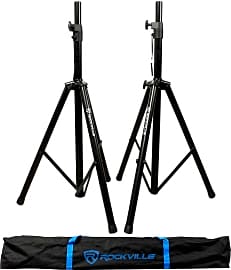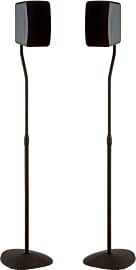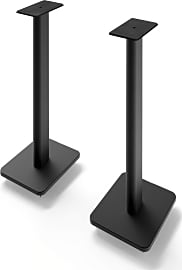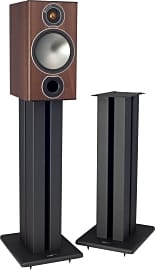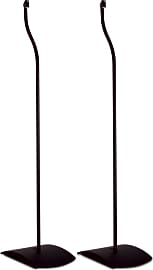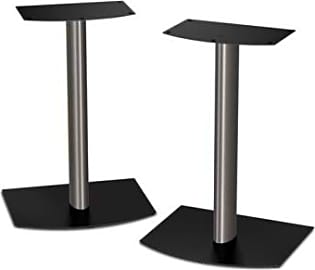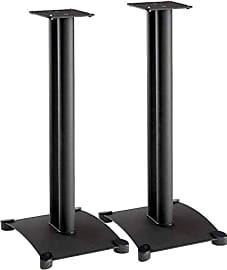The 10 Best Speaker Stands

This wiki has been updated 39 times since it was first published in September of 2015. If optimizing the sound quality of your entertainment system is important to you, speaker stands can make a considerable difference. By utilizing features like resonance damping, weighted bases, carpet spikes, and rubber feet, they help to reduce vibration, which is a common issue with floor-standing and bookshelf speakers. Here you will find the ideal solution to suit your home audio setup. When users buy our independently chosen editorial selections, we may earn commissions to help fund the Wiki.
Editor's Notes
April 22, 2021:
While smaller speakers are often referred to as "bookshelf" models, it is arguable that they are anything but, as most bookshelves are not up to the task, from placement, cable management, and acoustic perspectives. A well-matched pair of speaker stands will not only help you get the most out of your speakers sonically, but they make an aesthetically pleasing addition to your living space.
As a speaker cone's movement fluctuates, vibrations are transferred through flooring, shelving, masonry, or anything else within close range, and a speaker stand absorbs much of this vibration and supports it firmly, to ensure that you get the clearest sound projection possible from your cherished stereo equipment.
When choosing our selection for this ranking we included a mix of universal models which can support a large range of speakers, to bespoke OEM models, such as the Bose UFS-20 Series and the Bose FS-1, which are a justified choice in that they combine with two of this quality manufacturer's most popular products.
The greater the mass of the stand, the better the vibration-absorbing properties and stability, and it is with this in mind that we included the Pangea Audio DS400 and the Sanus SF30-B1, both of which can be filled with sand or lead shot, to weigh them down and bulk up their cores.
Similarly, the Ultimate Support MS-90 have the capacity to hold ballast but took it a step further by creating three internal chambers, one of which is fillable, while the other two are reserved for cable and power cord management. Not only does this create a neat and tidy solution, but results in a fully floating system that is usually seen in supports costing several times the price.
January 02, 2020:
The only item we chose to eliminate was the VideoSecu MS07B, as reports suggested an alarming lack of stability. Heavy speakers will cause them to tip over, which can lead to broken equipment or even injury.
We also gave the Sanus NF36 a minor downgrade — while they’re attractive and help generate high sound quality, the wire concealment system doesn’t work very well, and some feel that the speaker platform should be a bit larger.
The Rockville RVSS2 — our only new addition — is supported by a tripod base versus a traditional single shaft, which allows it to accommodate more weight than most models. It’s also super portable and comes with a carrying bag, making it a favorite of DJs and live event specialists.
Special Honors
Output Stands Handcrafted with heavy-duty steel, these workhorse platforms offer six inches of height flexibility and swiveling pedestals so you can direct the sound to a specific portion of the room. The acoustic spikes on the base allow you to anchor them to the ground if you wish. output.com
Mapleshade Air Aesthetically, it’s tough to overlook the elegance and craftsmanship of these stands from Mapleshade. In terms of performance, they’re designed to bring out the full potential of your speakers, whether they’re situated on tile, plywood, granite or concrete floors. They’re available in a variety of styles. mapleshadestore.com
HTD Stands You probably wouldn’t consider these luxurious, but their semi-glossy lacquer and minimalist construction should bring an understated charm to the room. A secret channel hides cables from view, and their wide base is held firmly in place by four tough non-slip pads. htd.com
Custom Design FS 104 Signature This pair of specialist stands have four one-inch diameter columns surrounding a wider central pedestal, which can be filled with the brand's special inert filler to effectively add mass and absorb vibration. The materials used are also particularly high-quality, with a pickled mild steel bottom plate, their special energy-absorbing inert "Acoustic Steel" top plate, and zinc-plated fixing bolts. customdesign.kemela.com
Standing Out Without Standing In The Way
The base is the widest part of the stand and keeps the speaker from falling over.
There is no denying the perceived power of music as a tool for human expression, communication, and unity. While it may be considered a stretch to call it a universal language definitively, music does bring people together in ways that often transcend race, ethnicity, culture, space, and time. This can hold true regardless of the method by which high-definition audio content is delivered to the human ears. In reference to that point, if you're not restricted to the use of a pair of headphones to listen to music, then high-quality speakers will become your new best friends. Even more important than a speaker's aesthetics is where and how it is positioned in a given space to ensure delivery of the purest and most unadulterated listening experience possible to the largest group of people at the same time. In order to achieve this goal, you'll need a sturdy set of speaker stands.
Aside from the consideration of aesthetics, a speaker stand is a mounting device that an audiophile can use to direct high-frequency sound waves (coming from either a stereo system or television) in a manner most suitable to their environment. Ideally, a speaker stand facilitates the delivery of premium-quality audio to a given audience at ear level, ensuring minimal distortion or loss of detail.
But could you experience awesome, uncompromised sound by placing your equipment on a bookshelf? In order to answer this question, we must first consider the basic principles of a loudspeaker along with a stand's major benefits to realize how the two work together and why a bookshelf setup might not be the optimal choice in every circumstance.
We tend to think of a loudspeaker as a fixed box (or cabinet) that produces sound using its internal moving cone and other components. While most of the sound comes from the cone, so do ancillary vibrations as a direct result. Regardless of how heavy and durable a cabinet might be, these vibrations will cause it to move slightly in one direction or another. Keeping that in mind, the ideal speaker support system will prevent excessive vibrations from being transferred to other nearby objects like floors, desktops, or elaborate shelving, while simultaneously keeping the cabinet firmly in place. The major drawback to placing speakers on those fancy bookshelves or hardwood floors, then, is their contact with surfaces. Most of our options have minimum surface area, meaning they don't obstruct the effective delivery of hi-fi audio to a listener's ears. The closer a surface is to a speaker, the greater the chance for early reflection and sound distortion, hence the reasoning behind centering speaker stands rather than placing them in corners or next to walls. For example, by centering two speaker stands on either side of that brand new 4K television in the middle of your living room, the projected sound has a direct path to your ears without having to bounce off other interior boundaries on the way.
Speaker stands are typically constructed from either wood or metal. Metal stands offer plenty of weight and stability, and are often painted in black or other colors to blend in with their surroundings. Wooden stands generally offer a similar degree of sturdiness to their metal counterparts. But when they're hollow, this creates the need to be filled with sand, lead shot, or some other material to prevent excessive movement due to vibrations and sound pressure. Additional stand components include top plates and bases. Most top plates are made from rubber for a superior grip on the entire speaker cabinet. The top plate usually features a pre-drilled hole in the center, making it easy to mount equipment. The base is the widest part of the stand and keeps the speaker from falling over.
Sounding Out Your Options
When hunting for a speaker stand, you should look for one with a dedicated compartment for sand that can accommodate extra weight. This is beneficial for use in large rooms when sound dampening and overall stability are your top concerns. A stand with good weight won't topple over easily, providing extra safety when you have children or pets running around the house.
Height is an extremely important factor to keep in mind, as well.
Consider an option that includes spiked feet. Not only do the spikes serve to keep the stand stable on carpeting and hard floors, but they further assist in minimizing vibration and distortion, which can come in handy if you watch a lot of high-volume action films or sports programming with a lot of people around.
Height is an extremely important factor to keep in mind, as well. Many stands give you the choice of adjusting the overall height of their top plates, depending on the size and acoustics of the surrounding environment. The best speaker stands are those that allow you to keep the tweeters at ear level, making adjustability a key convenience.
If you have a lot of equipment in your entertainment space, look for a set of stands with integrated channels for cable routing, as this will minimize excess clutter along the floor or behind the speakers themselves.
A Brief History Of Speaker Stands
The loudspeaker itself dates back to the latter part of the 19th century, when Johann Philipp Reis installed one of the first of these devices in his telephone in 1861. Alexander Graham Bell later patented his first electric loudspeaker in 1876, capable of reproducing intelligible speech for the purpose of a telephone patent.
Up until that time, most traditional furniture had not been fashioned to dampen vibrations or enhance sound quality.
By the 1930s, loudspeaker manufacturers began to include additional drivers in order to improve overall frequency response and sound pressure levels.
Speaker stands didn't gain a lot of popularity until the 1970s. Up until that time, most traditional furniture had not been fashioned to dampen vibrations or enhance sound quality. That said, the speaker stand evolved as a purpose-built accessory attributed to hi-fi enthusiasts and professional musicians who discovered that lifting speakers off the ground and isolating them from those excess vibrations would improve audio quality.



